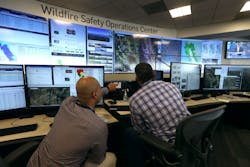15 Things You Need to Know About PG&E’s Public Safety Power Shutoff
Pacific Gas and Electric Co. (PG&E) recently shared a fact sheet, "15 Things You Need to Know About PG&E’s Oct. 9-12 Public Safety Power Shutoff (PSPS)."
During the PSPS Event
1. PG&E crews and contractors inspected nearly 25,000 miles of distribution lines and 2500 miles of transmission lines after the event, a combined distance that’s longer than a trip around the earth.
2. More than 100 instances of damage were found during inspections, including trees into lines and downed power lines, with the analysis of additional damage reports ongoing. It is possible that any one of these instances could have been a potential source of ignition, had a PSPS not been initiated.
3. The PG&E’s meteorologists and fire-weather experts participated in daily interagency calls with experts from multiple National Weather Service (NWS) offices and the Northern Operations Predictive Services. All the experts were aligned that this was a very high fire-risk event and had all the ingredients necessary for significant fires. The NWS issued a Red Flag Warning — lasting from the afternoon of Oct. 9 till the morning of Oct. 11 — that included locations where 2.1 million of the PG&E’s customers live. The Red Flag Warning encompassed a larger area than the PSPS footprint. Maximum wind gusts exceeded 50 mph in 16 counties impacted by the PSPS event:
- Sonoma County: 77 mph
- Contra Costa County: 75 mph
- Tehama County: 61 mph
- Sierra County: 59 mph
- Butte County: 56 mph
- Napa County: 54 mph
- Santa Cruz County: 54 mph
- Placer County: 53 mph
- Yolo County: 53 mph
- Solano County: 53 mph
- Alameda County: 52 mph
- Humboldt County: 52 mph
- Kern County: 51 mph
- Lake County: 51 mph
- Mendocino County: 51
- Santa Barbara County: 50 mph
4. The vast majority of the 738,000 customers in 35 counties impacted by the PSPS were restored within 48 hours.
5. Representatives from California Department of Forestry and Fire Protection (CAL FIRE), California Public Utilities Commission (CPUC), and California Governor's Office of Emergency Services (Cal OES) were in the PG&E’s Emergency Operations Center, participating in discussions. The company also held twice daily calls with state agencies and calls with county agencies three times a day. To prepare for the wildfire season, weekly meetings were held with state agencies and 17 planning workshops were held with cities, counties, and public-safety agencies.
6. In all, 6300 personnel, including PG&E workers and contractors, supported the PSPS.
7. The PG&E dispatched 44 helicopters to do aerial inspections.
8. The PG&E’s Customer Care team completed multiple daily notifications to customers before, during, and after the event. This included notifications and support of more than 30,000 Medical Baseline customers.
9. The PG&E opened more than 30 Community Resource Centers (CRCs) in PSPS-affected areas, providing water, restrooms, phone-charging, and other services. In all, more than 5400 customers visited a CRC.
10. The PG&E placed advertisements on TV, radio, and digital sites. The company used Facebook, its nine Twitter accounts, and NextDoor to share updates on the PSPS and conducted more than 900 interviews with the media during the event.
Before the PSPS Event
11. In 2012, just 15% of the PG&E’s territory was designated as having an elevated wildfire risk on the fire-threat maps in effect at that time. Today, in 2019, approximately 50% of the service area is in Tier 2 or Tier 3 high fire-threat areas.
12. The PG&E’s electric infrastructure underwent an unprecedented inspection and repair process earlier this year. More than 700,000 electric-system poles, towers, and substations were inspected, and any items needing immediate repair were mended.
13. To prepare for the wildfire season, the PG&E sent letters/emails to about five million customers; sent out more than seven million PSPS-related emails; participated in 998 meetings with cities, counties, customers, and community groups; and held 23 community open-house events throughout the service area.
14. The PG&E has installed 600 weather stations and 100 high-definition cameras in high fire-threat districts for increased situational awareness. The PG&E has also deployed its Satellite Fire Detection and Alerting System, which incorporates data from five satellites to provide advanced warnings of new potential fire incidents.
15. The PG&E reached out to its customers to make sure the company had accurate contact information. So far this year, 246,932 customers have updated their information including 10,966 Medical Baseline customers.
